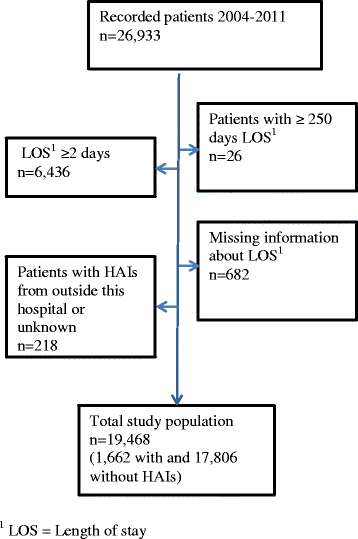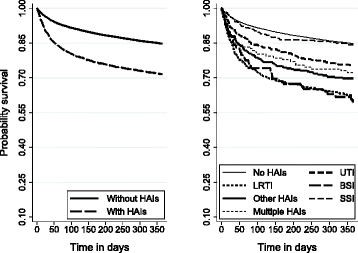Mortality related to hospital-associated infections in a tertiary hospital; repeated cross-sectional studies between 2004-2011
- PMID: 26719795
- PMCID: PMC4696323
- DOI: 10.1186/s13756-015-0097-9
Mortality related to hospital-associated infections in a tertiary hospital; repeated cross-sectional studies between 2004-2011
Abstract
Background: Hospital-associated infections (HAIs) are reported to increase patient mortality and incur longer hospital stays. Most studies to date have focused on specific groups of hospitalised patients with a rather short follow-up period. In this repeated cross-sectional study, with prospective follow-up of 19,468 hospitalized patients, we aimed to analyze the impact of HAIs on mortality 30 days and 1 year after the prevalence survey date.
Methods: The study was conducted at Haukeland University Hospital, Norway, a large combined emergency and referral teaching hospital, from 2004 to 2011 with follow-up until November 2012. Prevalence of all types of HAIs including urinary tract infections (UTI), lower respiratory tract infections (LRTI), surgical site infections (SSI) and blood stream infections (BSI) were recorded four times every year. Information on the date of birth, admission and discharge from the hospital, number of diagnoses (ICD-10 codes) and patient's mortality was retrieved from the patient administrative data system. The data were analysed by Kaplan-Meier survival analysis and by multiple Cox regression analysis, adjusted for year of registration, time period, sex, type of admission, Charlson comorbidity index, surgical operation, use of urinary tract catheter and time from admission to the prevalence survey date.
Results: The overall prevalence of HAIs was 8.5 % (95 % CI: 8.1, 8.9). Patients with HAIs had an adjusted hazard ratio (HR) of 1.5 (95 % CI: 1.3, 1.8,) and 1.4 (95 % CI: 1.2, 1.5) for death within 30-days and 1 year, relative to those without HAIs. Subgroup analyses revealed that patients with BSI, LRTI or more than one simultaneous infection had an increased risk of death.
Conclusions: In this long time follow-up study, we found that HAIs have severe consequences for the patients. BSI, LRTI and more than one simultaneous infection were independently and strongly associated with increased mortality 30 days and 1 year after inclusion in the study.
Keywords: Blood stream infection; HAIs; Hospital associated infections; Lower respiratory tract infection; Mortality; Prevalence.
Figures
Similar articles
-
Need for more targeted measures - only less severe hospital-associated infections declined after introduction of an infection control program.J Infect Public Health. 2015 May-Jun;8(3):282-90. doi: 10.1016/j.jiph.2014.11.001. Epub 2014 Dec 5. J Infect Public Health. 2015. PMID: 25488823
-
Hospital- and community-acquired infections: a point prevalence and risk factors survey in a tertiary care center in Saudi Arabia.Int J Infect Dis. 2006 Jul;10(4):326-33. doi: 10.1016/j.ijid.2005.06.013. Epub 2006 May 4. Int J Infect Dis. 2006. PMID: 16678467
-
Point prevalence and risk factors of hospital acquired infections in a cluster of university-affiliated hospitals in Shiraz, Iran.J Infect Public Health. 2012 Apr;5(2):169-76. doi: 10.1016/j.jiph.2011.12.004. Epub 2012 Feb 20. J Infect Public Health. 2012. PMID: 22541264
-
Types of urethral catheters for management of short-term voiding problems in hospitalized adults: a short version Cochrane review.Neurourol Urodyn. 2008;27(8):738-46. doi: 10.1002/nau.20645. Neurourol Urodyn. 2008. PMID: 18951451 Review.
-
[Hospital infection prevention in an intensive care unit].Ann Ig. 2004 Jan-Apr;16(1-2):187-97. Ann Ig. 2004. PMID: 15554525 Review. Italian.
Cited by
-
Characteristics and Outcomes for Low-Risk Hospital Admissions Admitted to the ICU: A Multisite Cohort Study.Crit Care Explor. 2021 Dec 9;3(12):e0596. doi: 10.1097/CCE.0000000000000596. eCollection 2021 Dec. Crit Care Explor. 2021. PMID: 34909699 Free PMC article.
-
Healthcare-associated infections: potential for prevention through vaccination.Ther Adv Vaccines Immunother. 2018 Feb;6(1):19-27. doi: 10.1177/2515135518763183. Epub 2018 Mar 14. Ther Adv Vaccines Immunother. 2018. PMID: 29998218 Free PMC article. Review.
-
Epidemiology of Healthcare-Associated Infections and Adherence to the HAI Prevention Strategies.Healthcare (Basel). 2022 Dec 26;11(1):63. doi: 10.3390/healthcare11010063. Healthcare (Basel). 2022. PMID: 36611523 Free PMC article.
-
Incidence and risk factors for hospital-acquired infection among paediatric patients in a teaching hospital: a prospective study in southeast Ethiopia.BMJ Open. 2020 Dec 17;10(12):e037997. doi: 10.1136/bmjopen-2020-037997. BMJ Open. 2020. PMID: 33334828 Free PMC article.
-
Prescriptive appropriateness of dalbavancin in acute bacterial skin and skin structure infections in adults: an integrated approach between clinical profile, patient- and health system-related factors and focus on environmental impact.Front Antibiot. 2024 Apr 24;3:1405401. doi: 10.3389/frabi.2024.1405401. eCollection 2024. Front Antibiot. 2024. PMID: 39816249 Free PMC article. No abstract available.
References
-
- Bruun T, Loewer HL. Prevalence surveillance system of nosocomial infections in Norway. Euro Surveill. 2007;12(8):E070830.2. - PubMed
-
- WHO. Report on the Burden of Endemic Health Care-Associated Infection Worldwide 2011 [updated 07.08.2015]. Available from: http://apps.who.int/iris/bitstream/10665/80135/1/9789241501507_eng.pdf?ua=1. Access date 10.08.2015.
LinkOut - more resources
Full Text Sources
Other Literature Sources



